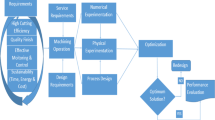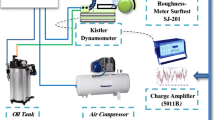Abstract
Aluminium alloy is increasingly being used in the industries because of its high strength to weight and corrosion resistance ability. However, there is a need to investigate its machinability to ensure that it will meet the quality and functional requirements for its intended applications. Hence, this study employs the computer-aided simulation and experimental approach to investigate the machinability of Al 6065 T6 using response surface methodology (RSM) during milling operation. The RSM was implemented in the Design Expert 2022 environment and the designed experiment produced 20 experimental trials whose responses specifically, maximum contact stress, reaction force, and surface roughness determined via modelling and simulation in the Complete Abaqus Environment (CAE). The validation of the numerical analysis was done by conducting physical experimentations. This established the feasible range of process parameters that can ensure effective machinability of Al 6065 T6 during milling operation. The values of the process parameters that produced the least surface roughness for both the computer-aided simulation and experimental approaches are feed rate (0.07 mm/rev), cutting speed (15 m/min), and tool slip factor (25%). Furthermore, predictive models were developed for estimating the magnitude of maximum contact stress, reaction force, and surface roughness. The statistical analysis of the predictive models indicates that they are suitable for predictive purposes. The outcome of this study adds to the understanding of the machinability of Al 6065 T6. The empirical results can assist machinists to develop products from Al 6065 T6 that will meet the required service requirements.












Similar content being viewed by others
Data availability
The data that support the findings of this study is included in the article and has been referenced accordingly.
References
Bibili Nzegue AG, Mpofu K, Mathe N, Daniyan IA, Muvunzi R (2023) An experimental investigation of selective laser process parameters on aluminium alloy (AlSi12). Procedia CIRP 118:638–642
Abdelaoui FZE, Jabri A, Barkany AE (2023) Optimization techniques for energy efficiency in machining processes—a review. Intl J Adv Manuf Technol 125(7–8):2967–3001
Camposeco-Negrete C, de Dios Calderón-Nájera J (2019) Optimization of energy consumption and surface roughness in slot milling of AISI 6061 T6 using the response surface method. Intl J Adv Manuf Technol 103:4063–4069
Tlhabadira I, Daniyan IA, Masu L, Mpofu K (2020) Development of a model for the optimization of energy consumption during the milling operation of titanium alloy (Ti6Al4V). Mater Today: Proc 38:614–620
Sangwan KS, Kant G (2017) Optimization of machining parameters for improving energy efficiency using integrated response surface methodology and genetic algorithm approach. Procedia CIRP 61:517–522
Yazdi MS, Khorram A (2010) Modeling and optimization of milling process by using RSM and ANN methods. IACSIT Intl J Eng Technol 2(5):474–480
Phokobye SN, Daniyan IA, Tlhabadira I, Masu L, VanStaden LR (2019) Model design and optimization of carbide milling cutter for milling operation of M200 tool steel. Procedia CIRP 84:954–959
Camposeco-Negrete C, de Dios Calderón-Nájera J (2019) Sustainable machining as a mean of reducing the environmental impacts related to the energy consumption of the machine tool: a case study of AISI 1045 steel machining. Intl J Adv Manuf Technol 102:27–41
Ochengo D, Liang L, Wei Z, Ning H (2022) Optimization of surface quality and power consumption in machining hardened AISI 4340. Adv Mater Sci Eng, Article ID 2675003, pp. 1-12
Nguyen TT, Nguyen TA, Trinh QH (2020) Optimization of milling parameters for energy savings and surface quality. Arab J Sci Eng 45(11):9111–9125
Hsiao TC, Vu NC, Tsai MC, Dang XP, Huang SC (2021) Modeling and optimization of machining parameters in milling of INCONEL-800 super alloy considering energy, productivity, and quality using nanoparticle suspended lubrication. Measure Control 54(5–6):880–894
Garg GK, Garg S, Sangwan KS (2018) Development of an empirical model for optimization of machining parameters to minimize power consumption. In IOP Conf Ser Mater Sci Eng 346:012078
Jia S, Wang S, Zhang N, Cai W, Liu Y, Hao J, Zhang Z, Yang Y, Sui Y (2022) Multi-objective parameter optimization of CNC plane milling for sustainable manufacturing. Environ Sci Pollut Res, pp.1–22
Phokobye SN, Desai DA, Tlhabadira I, Sadiku ER, Daniyan IA (2023) Comparative analysis of the cutting performances of sialon ceramic, cubic boron nitride and carbide cutting tools for titanium machining. Intl J Adv Manuf Technol 128:3775–3786
Daniyan IA, Tlhabadira I, Mpofu K, Adeodu AO (2020) Process design and optimization for the milling operation of aluminum alloy (AA6063 T6). Mater Today: Proc 38:536–543
Daramola OO, Tlhabadira I, Olajide JL, Daniyan IA, Sadiku ER, Masu L, VanStaden LR (2019) Process design for optimal minimization of resultant cutting force during the machining of Ti-6Al-4V: response surface method and desirability functional analysis. Procedia CIRP 84:854–860
Daniyan IA, Tlhabadira I, Phokobye SN, Siviwe M, Mpofu K (2019) Modelling and optimization of the cutting forces during Ti6Al4V milling process using the response surface methodology and dynamometer. MM Sci J 128:3353–3363
Daniyan IA, Mpofu K, Adeodu AO (2019) Optimization of welding parameters using Taguchi and response surface methodology for rail car bracket assembly. Intl J Adv Manuf Technol 100:2221–2228
Daniyan IA, Adeodu AO, Ale F, Aderoba O (2023) Investigation of surface roughness of titanium alloy (Ti6Al4V) during turning operation using surface response methodology. 2023 IEEE 14th International Conference on Mechanical and Intelligent Manufacturing Technologies, Cape Town, South Africa from May 26–28, 2023. Published in IEEE Xplore, pp. 143–147
MatWeb Material Property Data: Al 6065 T5. [Online Available at https://www.matweb.com/search/datasheet_print.aspx?matguid=662c43b0f45043db9e0a4a852d34bf96 [Accessed 4th April, 2023]
Fameso F, Desai D, Kok S, Newby M, Glaser D (2020) Simulation of laser shock peening on X12Cr steel using an alternate computational mechanical threshold stress plasticity model. Intl J Adv Manuf Technol 111:1–11
Fameso F, Desai D (2020) Explicit analysis using time-dependent damping simulation of one-sided laser shock peening on martensitic steel turbine blades. Simulation 96(12):927–938
Fameso F, Desai D, Kok S, Armfield D, Newby M (2022) Residual stress enhancement by laser shock treatment in chromium-alloyed steam turbine blades. Materials 15(16):5682
Muvunzi R, Mpofu K, Daniyan IA, Fameso F (2022) Analysis of potential materials for local production of a rail car component using additive manufacturing. Heliyon 8(e09405):1–8
Yolacan TF, Schafer M (2022) Determination of slip factor between CNC-cut serrated surfaces of S355J2 steel plates. Building 12(7):995
Kokkirala S, Holmberg J, Klement U, Lundstrom R, Iwasaki H, Hosseini SB (2022) Effect of cutting parameters on the generated surface integrity of hard-turned martensitic AISI 52100 bearing steel. Procedia CIRP 115:154–159
Bicek M, Dumont F, Courbon C, Pusavec F, Rech J, Kopac J (2012) Cryogenic machining as an alternative turning process of normalised and hardened AISI 52100 bearing steel. J Mater Process Technol 21(2):2609–2618
Hosseini SB, Beno T, Klement U, Kaminski J, Ryttberg K (2014) Cutting temperatures during hard turning—measurements and effect on white layer formation in AISI 52100. J Mater Process Technol 214(6):1293–1300
Vazquez MKP, Giardini C, Ceretti E (2014) Cutting force modelling. In: Laperriere L, Reinhart G (eds) CIRP Encyclopaedia of Production Engineering. Springers, Berlin, pp 315–329
Gao Y, Wang G, Bermingham MS, Dargusch MS (2015) Cutting force, chip formation and tool wear during the laser-assisted machining a near-alpha titanium alloy BTi-6431S. Intl J Adv Manuf Technol 79(1949–1960):21
Seker U, Kurt A, Ciftci I (2004) The effect of feed rate on the cutting forces when machining with linear motion. J Mater Process Technol 146(3):403–407
Sui SC, Feng PF (2016) The influences of tool wear on Ti6Al4V cutting temperature and burn defect. Intl J Adv Manuf Technol 85(9–12):2831–2838
Aldas K, Ozkul I, Eskil M (2014) Prediction of surface roughness in longitudinal turning process by a genetic learning algorithm. Mater Test 5:375–380
Tien DH, Nguyen N-H, Quy TD, Thien NY (2019) Cutting forces and surface roughness in face milling of SKD61 hard steel. Strojniški vestnik – J Mech Eng 65(6):375–385
Tlhabadira I, Daniyan IA, Masu L, VanStaden LR (2019) Process design and optimization of surface roughness during M200 TS milling process using the Taguchi method. Procedia CIRP 84:868–873
Daniyan IA, Tlhabadira I, Daramola OO, Phokobye SN, Siviwe M, Mpofu K (2019) Measurement and optimization of cutting forces during m200 ts milling process using the response surface methodology and dynamometer. Procedia CIRP 88:28–293
Kumar MS, Kannan TTM, Giridharan S, Kumar PV (2014) Optimization of micro milling parameters of Al-6082 by ANOVA methodology. Intl J Mech Eng Robot Res 3(4):377
Samuel AU, Araoyinbo AO, Elewa RR, Biodun MB (2021) Effect of machining of aluminium alloys with emphasis on aluminium 6061 alloy–a review. In IOP Conference Series: Mater Sci Eng, 1107(1):012157)
Zhou L, Li J, Li F, Mendis G, Sutherland JW (2018) Optimization parameters for energy efficiency in end milling. Procedia CIRP 69:312–317
Camposeco-Negrete C (2015) Optimization of cutting parameters using response surface method for minimizing energy consumption and maximizing cutting quality in turning of AISI 6061 T6 aluminum. J Clean Prod 91:109–117
Bousnina K, Hamza A, Yahia NB (2022) Energy optimization for milling 304l steel using artificial intelligence methods. Intl J Auto Mech Eng 19(3):9928–9938
Kadirgama K, Abou-El-Hossein KA (2005) Power prediction model for milling 618 stainless steel using response surface methodology. Am J Appl Sci 2(7):1182–1187
Samsedeensadham S, Mohan A, ArunRamnath R, Thilak RK Optimization of machining parameters in drilling Ti-6Al-4V using user’s preference rating based TOPSIS In: Mohan, S., Shankar, S., Rajeshkumar, G. (eds) Materials, Design, and Manufacturing for Sustainable Environment. Lecture Notes in Mechanical Engineering. Springer, Singapore. https://doi.org/10.1007/978-981-15-9809-8_34
Samsudeensadham S, Krishnaraj V, Ramachandran A (2023) Multi-attribute optimization of drilling CFRP/Ti-6Al-4V alloy hybrid stacks using VIKOR. Proceedings of the Institution of Mechanical Engineers, Part E: J Process Mech Eng, 0(0). doi:https://doi.org/10.1177/09544089231206037
Acknowledgements
The authors acknowledge the Achievers University, Owo, Nigeria, where this work was carried out.
Author information
Authors and Affiliations
Contributions
The conceptualization, experimentation, results analysis, writing—original draft, visualization, data curation, format analysis, and editing were the collective work of the authors.
vdssvs
Corresponding author
Ethics declarations
Ethics approval
The study requires no ethical approval.
Consent to participate
This is not applicable to this study.
Consent for publication
This is not applicable to this study.
Competing interests
The authors declare no competing interests.
Additional information
Publisher's Note
Springer Nature remains neutral with regard to jurisdictional claims in published maps and institutional affiliations.
Rights and permissions
Springer Nature or its licensor (e.g. a society or other partner) holds exclusive rights to this article under a publishing agreement with the author(s) or other rightsholder(s); author self-archiving of the accepted manuscript version of this article is solely governed by the terms of such publishing agreement and applicable law.
About this article
Cite this article
Daniyan, I., Ale, F., Fameso, F. et al. Computer aided simulation and experimental investigation of the machinability of Al 6065 T6 during milling operation. Int J Adv Manuf Technol (2024). https://doi.org/10.1007/s00170-024-13772-9
Received:
Accepted:
Published:
DOI: https://doi.org/10.1007/s00170-024-13772-9




